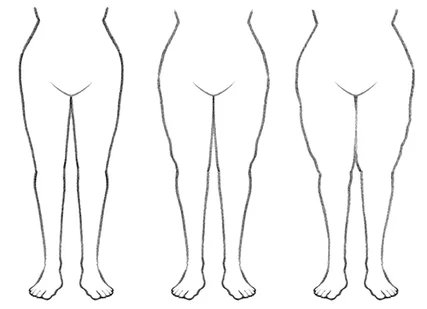Lipedema
On this page, you will learn about the development, causes, symptoms and different stages of lipedema.
What is Lipedema?
The term lipedema is a combination of the Greek words "lípos" (fat) and "oídma" (swelling) and describes a chronic and painful fat distribution disorder. Since the disease mainly affects the hips and thighs, while the rest of the body has normal proportions, it is also referred to as the "saddle bag phenomenon". Lipedema is very painful and patients often suffer from psychological distress due to their appearance. Adiposity (obesity) often accompanies the disease and causes additional stress for the patients.
What causes Lipedema?
Lipedema mainly affects women. Accordingly, there is reason to believe that female hormones are one cause of the disease. In addition, the chronic fat distribution disorder often breaks out at times of hormonal change, such as during puberty or pregnancy. In less frequent cases, lipedema occurs after or during menopause. The fact that the female fatty tissue has a different structure than the male fatty tissue could be another reason for the increased susceptibility of women.
Men are rarely affected by lipedema. If men are affected by lipedema, it is usually associated with other diseases (e.g. testosterone deficiency due to liver damage) or treatments (e.g. prostate carcinoma) that impair the male hormone balance.
In addition, lipedema is believed to be hereditary because of a certain predisposition to the disease.
Differentiation from other fat distribution disorders
Lipedema is a fat distribution disorder that affects the subcutaneous fat tissue. It causes an increase in the fat tissue in the subcutis. While a healthy diet or exercise cannot cure the disease, they can significantly improve the patient's quality of life.
In rare cases, "lipohyperplasia" (fat tissue proliferation) can also develop into lipedema. In contrast to this asymptomatic fat tissue proliferation, lipedema patients are sensitive to pressure and physical contact and quickly develop bruises.
Differential diagnoses
The following table may help differentiate between lipedema, lipohyperplasia and obesity:
| Typical clinical characteristics | Lipedema | Lipohypertrophy | Adiposity |
|---|---|---|---|
| Increase in fat | +++ | +++ | +++ |
| Disproportion | +++ | +++ | + |
| Edema | +++ | - | (+) |
| Sensitivity to pressure | +++ | - | - |
| Tendency to hematoma | +++ | + | - |

Why is the lymphatic system affected?
The additional fatty tissue and above all the accompanying adiposity put a strain on the lymphatic system. In the long run, this additional strain causes changes in the vascular walls and thus reduces their transport capacity. Over several years and without appropriate treatment, the lymphatic system becomes so overloaded that it suffers permanent damage. Without proper treatment, secondary lymphedema may develop in addition to lipedema after several years. This phenomenon is often referred to as mixed lymphedema or lipo-lymphedema. In order to counteract this, it is advisable to start treatment of lipedema early.
Important!
The right treatment can help reduce lipedema symptoms and significantly improve the patient's quality of life – e.g. with flat-knitted stockings. Learn more about Lastofa Forte, the flat-knitted medical compression stockings made from merino wool.

Symptoms of Lipedema
Lipedema can severely reduce the quality of life of those affected. In addition to the physical complaints, the disease can also cause severe emotional stress. The unusual proportions can be very unpleasant for the affected persons, causing them to feel uncomfortable with their appearance.
Typical characteristics of lipedema are symmetrical, spongy swellings in the shape of saddlebags. The term "spongy" also describes the typical, soft connective tissue and the associated orange skin (also known as cellulite). Lipedema can be distinguished visually from other forms of edema by the fact that it doesn't affect the hands and fingers or the feet and toes. In case of lipedema in the leg, the increase in fat stops at the ankles, causing the fatty tissue to overlap the ankle joint at an advanced stage. This is why we also speak of the suave pants phenomenon (or harem pants phenomenon).
Patients experience considerable discomfort, especially after long periods of standing and sitting or in the evening. They are very sensitive to pressure and physical contact and quickly develop bruises. Their arms or legs feel heavier and swollen as a result of the fluid retention. In addition, the patients describe discomfort ranging from a feeling of tension up to bursting pain.
The large circumferences of the thighs can interfere with running and cause the skin on the inside of the thighs to rub against each other. In addition, the increased weight of the limbs can lead to misalignments of the joints, including arthrosis.

Diagnosis: Lipedema
In order to diagnose lipedema, it is essential to examine the affected body regions. As a rule, the affected persons' body proportions are very unusual: for example, their upper body is slender to normal, with wide to very wide hips and thighs. The fact that the fat pads end at the feet and/or hands marks a clear distinction from lymphedema. In addition, patients should be tested for sensitivity to touch or pressure. In addition, imaging techniques such as sonography (ultrasound) can be used to visualize subcutaneous fat tissue.
The history of the patient should also be taken into account:
- Have family members been diagnosed with lipedema? – If so, it is conceivable that the disease was inherited.
- When was the increase in fat first observed? – For example, it is typical to see a change after puberty or pregnancy.
The course of the disease – The stages of Lipedema
The first signs of lipedema usually appear after hormonal changes, for instance after puberty, pregnancy or in rare cases after menopause. Most commonly, they are classified into three stages. It should be noted that this classification only accounts for a partial aspect of lipedema – the shape and appearance of the extremities, but not the complaints.
Stage I:
In the first stage, the surface of the skin is smooth and the subcutaneous tissue is enlarged. In addition, the fat structure is finely knotted and shows fine dents, also known as orange skin or cellulite.
Stage II:
During the second stage, the skin surface becomes uneven, the structure of the fatty tissue becomes coarsely knotted, resulting in rough dents.
Stage III:
The third stage is characterized by the fact that the tissue becomes rougher and harder. In addition, the skin develops large, bulky flaps.

Treating Lipedema
Treatment of lipedema is crucial for healing the disease. The treatment is based on Complex Decongestive Physiotherapy (CDP). It consists of various components. In addition, accompanying nutritional and exercise therapy can provide benefits.
Learn more about the treatment





